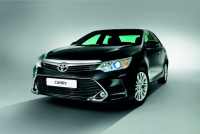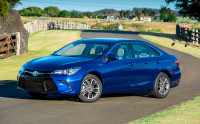Against the background of general instability in the automobile market, some models show steady growth figures. Not the least of these is the Toyota Camry, which in October 2014 was chosen by one and a half times more buyers than a year ago at the same time. These results are especially surprising just before the much-publicized release of the updated version.
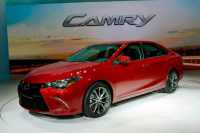 In no small measure, dealer discounts and the expectation of a significant price increase for the novelty contributed to this. Now the prices are known and sales have started. It turned out to be not that bad - even now there is a six-month waiting list for the most popular models.
In no small measure, dealer discounts and the expectation of a significant price increase for the novelty contributed to this. Now the prices are known and sales have started. It turned out to be not that bad - even now there is a six-month waiting list for the most popular models.
Japanese expansion
The history of the Camry began in 1982. The car was made on the basis of the Celica A60 coupe. The design was not original, but the car conquered by reliability and practicality. For the Japanese market, the car was offered under the name Vista. Thanks to its simple and durable design, the first-generation Vista and Camry V10 are still found on the roads.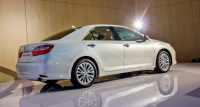 The V10, V20, V30, XV10 and V40, produced from '82 to '98, were in Class D. The cars were produced as sedans and station wagons. The Avalon was produced in the U.S. on the Camry platform. The XV20, introduced in 1997, was already in a more prestigious class E. Starting with this generation, the Camry wagon remained only in right-hand drive versions. For left-hand drive markets, only sedans were available. More than half of all Camry and its derivatives were traditionally sold in the U.S. and Canada, the rest found their owners mainly in the CIS countries and Japan. This trend continues for the XV30, XV40, and the XV50, which came to prominence in 2011.
The V10, V20, V30, XV10 and V40, produced from '82 to '98, were in Class D. The cars were produced as sedans and station wagons. The Avalon was produced in the U.S. on the Camry platform. The XV20, introduced in 1997, was already in a more prestigious class E. Starting with this generation, the Camry wagon remained only in right-hand drive versions. For left-hand drive markets, only sedans were available. More than half of all Camry and its derivatives were traditionally sold in the U.S. and Canada, the rest found their owners mainly in the CIS countries and Japan. This trend continues for the XV30, XV40, and the XV50, which came to prominence in 2011.
New Toyota Camry 2015
"Novelty", of course, is a restyling (recall that the last generation of Toyota began production 3 years ago - in 2011, and therefore, according to all the canons of the car world, it is time to change the model), but the designers are so carefully worked out Camry that it seems as if before you a new generation of car. Let's find out how seriously Toyota has changed.
Bold and comprehensive upgrades
It is impossible to confuse the updated version with the old one from any angle. The external changes are so dramatic that there were even rumors about a new generation. In fact, it is the same "fifty" with new plumage and optics. Opinions of potential buyers regarding the restyling cardinally differ. Someone categorically did not accept it and hurried to buy the previous version, someone is delighted with the changes.
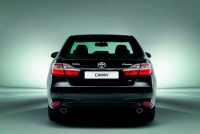 The Camry has formed the image of "director" cars, it is often bought by government agencies and private companies for use with a driver. The previous version looked stricter and more pompous, and therefore more consistent with the prevailing image. The new Camry became more aggressive and youthful. Many categorically dislike its design, which makes it resemble a less prestigious Corolla. The antenna in the form of a fin looks too similar to the ones put on BMW. The main plus is the diode headlights integrated into the optics.
The Camry has formed the image of "director" cars, it is often bought by government agencies and private companies for use with a driver. The previous version looked stricter and more pompous, and therefore more consistent with the prevailing image. The new Camry became more aggressive and youthful. Many categorically dislike its design, which makes it resemble a less prestigious Corolla. The antenna in the form of a fin looks too similar to the ones put on BMW. The main plus is the diode headlights integrated into the optics.
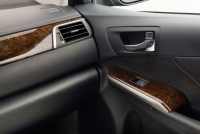 Internal changes have more unequivocal character. They are definitely for the benefit. Inlays for wood in the new version finally began to look like wood, but not like red plastic. Green backlight of a monochrome screen of a climate system has been removed, which is not solid and does not harmonize with anything. Now all displays are dominated by a blue background with white fonts. The backlighting of the symbols on the buttons and switches is neutral white.
Internal changes have more unequivocal character. They are definitely for the benefit. Inlays for wood in the new version finally began to look like wood, but not like red plastic. Green backlight of a monochrome screen of a climate system has been removed, which is not solid and does not harmonize with anything. Now all displays are dominated by a blue background with white fonts. The backlighting of the symbols on the buttons and switches is neutral white.
The dashboard scales also received a smart blue fill. It surprisingly does not seem annoying. The readability of the instruments is on an average level. The same can be said about the on-board computer screen between the tachometer and speedometer with a diagonal of 4.2 inches. Drawing is good, but the fonts are small.
 The new 3-spoke steering wheel is very good. Quality plump steering wheel with pleasant to the touch leather with coarse stitching. The leather upholstery of the seats still resembles a substitute, but it has become noticeably softer. In a new car with a leather interior, for some reason, the not so pleasant smell of plastic rather than leather dominates. Electrically adjustable seats are now with memory. In the legs there is a bluish illumination.
The new 3-spoke steering wheel is very good. Quality plump steering wheel with pleasant to the touch leather with coarse stitching. The leather upholstery of the seats still resembles a substitute, but it has become noticeably softer. In a new car with a leather interior, for some reason, the not so pleasant smell of plastic rather than leather dominates. Electrically adjustable seats are now with memory. In the legs there is a bluish illumination.
The central console has a touch screen of the multimedia system. In the top version its diagonal is 7 inches, in more modest versions it is 6.1 inches. It displays information from the rear-view camera, depending on the version with or without dynamic prompts. Navigation is included in expensive versions. The USB input was in a compartment with a lid, similar to an ashtray. Even with the most compact flash drives, the lid can not be closed.
Between the front seats is a compartment for wireless phone charging. Today, this function is supported by some LG and Nokia phones.
Owners of other phones can buy cases or stands, making such charging possible, but the convenience of this solution is questionable, it's easier to charge the device from USB.
Control of 2 or 3 zone climate is now without rotary knobs, all on the keys. The design is similar to what was offered in Mercedeses of the 90's, which is a little confusing.
For the more expensive versions with a third climate zone for rear passengers, its own control panel is located on the folding armrest. There are also buttons to control heated seats for the rear row, a high-end audio system JBL, electric drives to change the angle of the sofa back, the curtains on the rear window and the side windows of the second row. Comfort and spaciousness in the back seat are a traditional Camry feature, and they have not disappeared in the updated version.
All the plastic in the cabin has changed the texture. Good fit and Soft-touch coating please. In premium-class cars the tactile sensations are more pleasant, but here they tried to get closer to them. The Japanese have improved noise insulation of the updated version. In particular, its thickness has been increased in flooring and in front doors. At the allowed speeds the car is very quiet, but at high speeds the aerodynamic noises are in the foreground.
The heated windshield, blind spot monitoring system and automatic switching between low and high beam were added as nice options. The ignition key fob, which used to look rather dubious, has been improved.
Chinese-Japanese tandem
The main innovation of the domestic version is a completely new four-cylinder gasoline engine with a working volume of 2 liters with the index 6AR-FXE. It is confused by the Chinese origin of the engine and its absence in the European range. But it is very interesting due to its characteristics. This engine is equipped with the latest generation of combined injection and phase control systems.
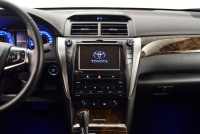 With a capacity of 150 hp and 199 Nm optimal for our market it accelerates a 1.5-ton car up to a hundred in 10.4 seconds. It is assisted by a classical 6 speed automatic transmission from Aisin. Japanese promise the mixed consumption for this tandem of 7,2 l/100km. In practice, you will have to add 1-1,5 liters to this indicator that is not bad either.
With a capacity of 150 hp and 199 Nm optimal for our market it accelerates a 1.5-ton car up to a hundred in 10.4 seconds. It is assisted by a classical 6 speed automatic transmission from Aisin. Japanese promise the mixed consumption for this tandem of 7,2 l/100km. In practice, you will have to add 1-1,5 liters to this indicator that is not bad either.
When working actively with the gas pedal, the box easily drops a few gears and gives adequate acceleration. The 2-liter engine gets loud, but it accelerates the car with confidence. The previous variant with the 2L engine and 4-speed automatic was 2 seconds slower and much less economical.
The characteristics of the 2.5L and 3.5L engines have not changed. Both are offered with the same 6-speed automatic. Manual gearbox is not necessary for this car.
Compromise
The restyled Camry has a tuned suspension and limited-slip differential. The Camry has improved cornering behavior, as well as stability and start on slippery surfaces.
The settings were shifted to the comfort area. The car became softer and more comfortable in the city, but it still shakes on a broken road. Unlike other cars of this class Camry has a good geometric cross-country ability with a fair clearance of 160 mm.
As a whole the car disposes to measured movement, but it does not mean that there is no possibility to drive it in the mood. Engines of 2,5 and especially 3,5 liters are very dynamical and easily allow moving faster than the main stream. Suspension is also quite collected; electric power steering is reliable and transparent. The roll could have been less, but this is the price to pay for comfort.
